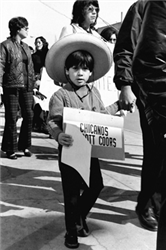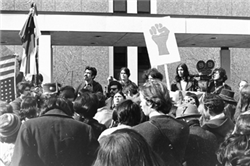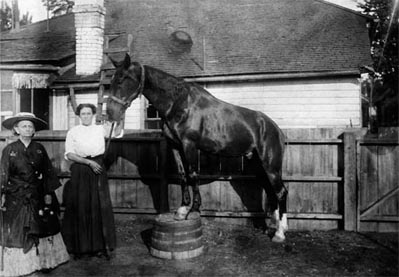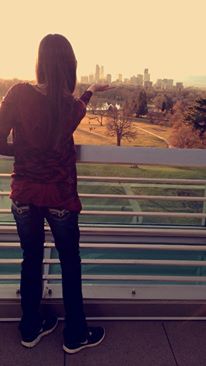Chicano Movement in Colorado
RODOLFO GONZALES RALLIES DENVER
Monika Mullins | Colorado History | November 20th, 2017
Throughout Colorado’s history children of Mexican immigrants have suffered through a series of hardships. Latinos in the 1900’s were expected to work in the fields of farms and if they were lucky got to go to school. If working hard was not bad enough they would suffer racism everywhere they went. It was unheard of anyone making a big deal about the way Latinos were being treated until the Chicano movement in the 1960’s. Men like Rodolfo “Corky” Gonzales and members of Denver’s Crusade for Justice would stand up for Chicano/Hispanic/Latino rights by pursuing a life of protesting. Rodolfo Gonzales being a professional boxer, writer and Chicano activist will make for better living of Chicanos in Colorado.
Much of Rodolfo “Corky” Gonzales’ activist pursuit is pursued in a variety of sources. One of those sources is a book written by Rodolfo himself called Message to Aztlán which is a collection of his writings during the height of the Chicano Movement. Another source is Denver’s Crusade for Justice: Chicano Militancy and the Government’s War on Dissent by Ernesto B. Vigil who was a Crusader himself and offers a chapter on Rodolfo’s legacy. A newspaper article “Poverty meets its match” in the Rocky Mountain News portrays the epic high school walkout riot that Rodolfo Gonzales rallied.
On that note, not all history can be summed up into words. In a time when Rodolfo Gonzales felt discriminated against by reporters; pictures manage to be the best primary sources of the time. One of the images that tells the most about the time going on is an image of Rodolfo Gonzales speaking at a rally where there are protestors holding an upside down American flag and another holding power fist sign. Corky, as they called him, was known for giving speeches not only in Colorado but to New Mexico and California inspiring Hispanics every step of the way.
To show off more of the protests the next image shows Gonzales speaking at an anti-war protest in Denver. The Chicano movement had a big take off because Mexican Americans were drafted into Vietnam but were not able to get rights at home. This infuriated a lot of Chicanos who wanted more rights to land.
If Racism could not have been the biggest issue of the Chicano movement the last image is from the protest at Coors Brewery. Coors Brewery was refusing to hire Hispanics, and this caused a major outrage among Chicanos. Rodolfo Gonzales and the Denver Crusaders took to the sidewalks to protest. In the image a little boy is pictured protesting symbolizing how important rights were to the entire community.
A major source of information about Rodolfo comes from an exhibit in the library named after Rodolfo Gonzales in Denver. Rodolfo Gonzales was the last child born of 8 and if having a big family did not seem like a struggle his mom died at age of 2. His dad Federico managed to raise him and his siblings in not only the great depression but in the hood of Denver. Regardless of being poor Rodolfo worked in the beets fields and attended high school. Surprisingly Gonzales graduated and went to the Denver University for engineering but because of the high price he dropped out. This is when Gonzales pursued a major career in boxing. He retired in 1955 after “ a record of 63 wins, 11 losses, and 1 draw.”
Gonzales was a people person “owning a popular lounge called ‘Corky’s Corner’ and later started a bail bond company” Which is most likely what lead him to found the Latin American Educational Fund, the Colorado GI Forum and the Latin American and Research and Service Agency. When transitioning to the political part of his life Gonzales brought his fight with him when he beat up a Denver Patrolman for harassing Mexican Americans for no reason. Police brutality was a major issue even though Denver already had a large Hispanic population.
When Gonzales left his campaign of being a Democrat candidate “he took on founding the Crusade for Justice in 1966” which was one of the biggest Mexican American activist groups in Colorado and also a Summer school of freedom. He would travel from Colorado to New Mexico and California to give speeches. Soon he would become a big staple in the Chicano Movement. Every speech would advocate for social change and Chicano nationalism. Eventually, his summer school would get turned into the “Esculea Tlateco a bilingual school fostering empowerment and cultural pride”
In 1967 Rodolfo “Corky” Gonzales amazes the world with his poem Yo Soy Joaquin. Of course, inspired by his work in the Chicano Movement he becomes a founding writer in Chicano Literature. Rodolfo takes on his struggles “La Raza! Mejicano! Espanol! Latino! Hispano! Chicano! or whatever I call myself, I look the same, I feel the same, I Cry, and Sing the same. I am the masses of my people and I refuse to be absorbed.” and makes them into an art that is now studied at college institutions. A lot of people question how he could ever pursue such a masterpiece of a poem, but it was known that Gonzales “spent a lot of time with other activists such as Martin Luther King Jr, César Chávez, and many others.” This poem also lead him to create the first ever Chicano Youth Liberation conference.
In the Summer of 1968, Rodolfo goes to Washington to lead 1,000 immigrants in the Southwestern Contingent of the march on Washington D.C. as apart of the Poor People’s Campaign and Demonstration. Prior to this Gonzales marched with Cesar Chavez, the founder of United Farm Workers.
March 21, 1969, Rodolfo Gonzales hits the “Rocky Mountain” headlines in the biggest way possible. “Several hundred West High School students fought with police on the front steps of the school Thursday after walking out of classes in protest over alleged racial slurs by a teacher,” Gonzales rallied a bunch of Chicano and Chicana teenagers to have a walkout at their high school to get a teacher fired for racial slurs used at a fellow student. Because the Crusade was involved the group of about 300 students was met with police in riot gear. The police told them to protest at the park but by the time they crossed to the park police started hitting the students. The “West Side Recorder” reported “Everything broke loose — nightsticks started swinging and cops were pulling girls’ hair by the handful. Nearly every cop I saw had a mindless look and was beating kids savagely.” The walkout ended up lasting 3 days and Rodolfo along 25 others got arrested.
One of the last major events that happen in Rodolfo’s time in the Chicano Movement is when the police manage to raid the Crusade for Justice headquarters. This happens right after Luis “Junior” Martinez a Chicano activist also a part of the Crusade for Justice and founder of the Black Berets was assassinated by police in Denver. The headquarters ends up being blown up by a bomb that everyone believes to this day was set off by the police because of “the acquisition of the FOIA document from the FBI.” This will forever be known as the “March 17th Confrontation.”
Rodolfo “Corky” Gonzales ends up dying April 12th, 2005 at home with his wife and children in Denver, Colorado suffering from heart failure. Gonzales will be remembered as being important to Colorado for making a way for Chicanos/Latinos/Hispanics for years to come. He will also be known for leaving behind Chicano literature including plays, poems, and social activist speeches. There is also a Denver branch library in his name and his bilingual school is still in operation to this day. Rodolfo’s legacy of Chicano will never be forgotten in Colorado.




One response to “Chicano Movement in Colorado ”
Hello. This post was really remarkable, particularly because I was looking for thoughts on this subject last Sunday. Derek Liedy